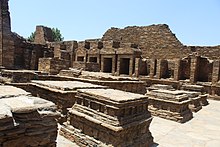
Mardān (Pashto and Urdu: مردان; Urdu ; Pashto: ) is a city in the Mardan District of Khyber Pakhtunkhwa Province, Pakistan.[6] Located in the Valley of Peshawar, Mardan is the second-largest city of Khyber Pakhtunkhwa (after Peshawar).[7][8] It is a fast-growing city that experienced a population boom in the latter half of the 20th century.
Around 1800 BCE, the area around Mardan was part of the homeland of the Gandhara grave culture. Rock edicts of the ancient Indian King Ashoka in the nearby Shahbaz Garhi, written in the right-to-left Kharosthi script, date from the Mauryan period (mid-200s BCE) and represent the earliest irrefutable evidence of writing in South Asia.[9] The nearby Takht-i-Bahi which has remains of an ancient Buddhist monastery was listed as a UNESCO World Heritage Site in 1980.[10]
History
| Year | Pop. | ±% p.a. |
|---|---|---|
| 1951 | 48,827 | — |
| 1961 | 77,932 | +4.79% |
| 1972 | 115,194 | +3.62% |
| 1981 | 147,977 | +2.82% |
| 1998 | 245,926 | +3.03% |
| 2017 | 358,604 | +2.01% |
| Source: [11][5] | ||
Mardan is located in a region rich in archaeological sites. In 1962, the Sanghao Caves were discovered outside of Mardan, which yielded artefacts from the Middle Paleolithic period,[12] over 30,000 years ago. Other sites in the immediate area have yielded evidence of human activity from the Upper Paleolithic period.[12] Further excavations from the area around Jamal Garhi near Mardan recovered artefacts from the Mesolithic period.[12]

 The Takht-i-Bahi complex near Mardan dates from the first century CE.
The Takht-i-Bahi complex near Mardan dates from the first century CE.The area around Mardan then formed part of the homeland of the Gandhara grave culture around 1800 BCE. The Gandharan grave culture appears to have been a Central Asian group that may represent part of the Indo-Aryan invasion into the subcontinent.[13] Mardan then formed part of the ancient Buddhist kingdom of Gandhara. Rock edicts of Ashoka in nearby Shahbaz Garhi date from the Mauryan period in the mid-200s BCE, and are written in the ancient Kharosthi script.[9]
The nearby UNESCO World Heritage Site of Takht-i-Bahi was established as a monastery around 46 CE. The Bakhshali manuscript, which contains the earliest record of the use of the number 0 in the Indian subcontinent,[14] was found near Mardan in 1891, and dates from the third or fourth century CE. It is the oldest extant manuscript in Indian mathematics. The nearby Kashmir Smast caves served Buddhist hermit monks, and dates from the fourth to ninth century CE.
